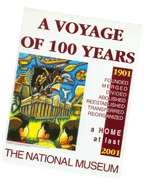PLANETARIUM

Function
Disseminate scientific and cultural aspects of astronomy; Research in the field of basic astronomy.
Historical Notes
It all started with a heavenly vision. n 1970, the Philippine Astronomical Society (PAS), the only astronomical club in the country, persuaded then National Museum Director Godofredo Alcasid, Sr. to put up a planetarium or space museum in Manila. The project required an initial allocation of US$100,000 which was obtained from the Japanese Reparation Program.
Then First Lady Imelda R. Marcos, a benefactor of the National Museum, became immensely interested with the project that towards the end of 1974 construction of the building had begun and fabrication of the Planetarium Projector by Japanese engineers was finished before the middle of 1975. Cognizant of the need to have an astronomy expert to head the Planetarium, Director Alcasid requested Dr. Roman L. Kintanar, Director of Philippine Atmospheric, Geophysical, Astronomical Services Administration (PAGASA) for the transfer of Mr. Maximo P. Sacro, Jr., an original member of the Philippine Astronomical Society (PAS).
The National Museum Planetarium was formally inaugurated on October 8, 1975. Affirming 'its establishment was Presidential Decree No. 804A that was issued on September 30, 1975. The Planetarium's primary function is to disseminate astronomical information through planetarium shows, lectures, demonstrations, exhibits and actual celestial observations. The unique feature of the Planetarium is the true-to-life showing of astronomical bodies that captures the interest and tickles the imagination of viewers
Desirous of reaching out to more Filipino audiences, the National Museum offered free public programs at the Planetarium, under the generous sponsorship of the Philippine Charity Sweepstakes. Locally produced and canned planetarium programs complemented by science films loaned from US and Canadian Embassies were presented, and these included: Voyager of the Universe; Cosmos, Voyage to the Star; Skywatchers of Ancient Mexico; Alien Odyssey; Taurus, the Bull; and, Star of Bethlehem.
After 16 successful and productive years of operation, the space museum suffered a major disaster when the inner dome of the Planetarium, which also served as the screen, collapsed in June 1991. This fateful event led to the temporary closure of the Planetarium as employees were detailed with different divisions of the National Museum.
Turning Points
The first important turning point in the history of the Planetarium came in February 1982 when the PCSO donated funds for the purchase of audio-visual equipment to enhance the quality of the planetarium programs, comparable with other space museums in the world. As a result of this acquisition, more programs were exhibited to the delight of the viewing public. As its popularity increased, other shows were added including a regular Sunday Television Show entitled "Astro Quiz" that aired on Channel 2 and was hosted by Mr. Eddie Mercado.
Another planetarium program called, "Sun, Superstitions, and Eclipse" (SSE) was launched in preparation for the much awaited Total Solar Eclipse in 1988, wherein the center of the totality (LCD) was Davao City and Gen. Santos City. The SSE featured a slide lecture/demonstration of the eclipse observed in these areas. The Planetarium Division sent a team composed of the Curator, researchers, technicians, and photographers to observe the Total Solar Eclipse in Gen. Santos City on March 18, 1988. A beautiful photographic documentation of the solar eclipse was achieved which marked another major highlight in the Planetarium's existence.
The grand re-opening of the Planetarium in August 1996, after its closure for five years, was the monumental episode in the Division's lifetime. The rehabilitation project including purchase and installation of new equipment was made possible through appropriations from the government with a total cost of P12 million.
The last sunset of 1999 was a key phenomenon photographed at Rizal Park overlooking the Manila Bay and thus captured for posterity by the Planetarium.
A Broader Role
The Planetarium Division has remained true to its commitment to deliver and disseminate information on astronomy through lectures/demonstrations, exhibits and celestial simulations. Noteworthy, however, is its expanded role in the promotion of study and interest in space science through a variety of shows and programs intended for students and astronomy enthusiasts.
Aside from lecture-demonstrations, the Planetarium extends technical and scientific services to educational institutions.
Having the objective of information dissemination in mind, the National Museum Planetarium launched a project "Astronomical Observatory and Planetarium on Wheels" last October 2000 coinciding with its 25th anniversary. The project, which aims to bring the science of astronomy to the provinces, is equipped with an eight-inch telescope, state-of-the-art audio-visual equipment, such as the four-meter inflatable planetarium dome bought from Spain, portable star projector from Japan, a multi-media (LCD) projector, an eight-track digital audio-tape recorder, a laptop computer, digital camera and a digital printer.
Quest for Excellence
The first Curator of the Planetarium Division, Mr. Maximo P Sacro, Jr., is a recipient of several recognitions in the field of space science. Among these are: the Padre Faura Astronomy Medal for his outstanding accomplishment and contribution to the advancement of the science of astronomy in the Philippines given by the PAS; Kapwa Award in recognition of his personal efforts which contributes to the economy and improvement of the National Museum; and, Dr. Casimiro del Rosario Astronomy Award in recognition of his exemplary achievements in the Science of Astronomy in the Philippines given by PAGASA and DOST.
The appearance of the Comets Hyakutake and Hale-Bopp was observed and photographed by the Planetarium Division and featured in the leading newspaper.
True to its name, the Planetarium Division faces a celestial challenge requiring astronomical efforts. Through more orchestrated action and collaboration with the national government as well as non-governmental organizations, the Division is capable of reaching out to all sectors of society in its information dissemination campaign.
taken from the
"A Voyage of 100 Years"



